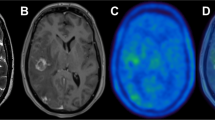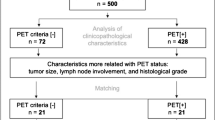Abstract
Purpose
This study retrospectively investigated the clinical utility of 2-deoxy-18F-fluorodeoxyglucose (18F-FDG) positron emission tomography/computed tomography (PET/CT) and circulating tumor cells (CTCs) in the diagnosis and prognosis of treatment-naive patients with non-small-cell lung cancer (NSCLC).
Methods
The blood samples of treatment-naive patients with NSCLC were collected for CTCs detection, and the tumor metabolic parameters of 18F-FDG PET/CT, including maximum standard uptake value (SUVmax), metabolic tumor volume of primary lesion (MTV-P) and combination of primary lesion and metastases (MTV-C), and total lesion glycolysis of primary lesion (TLG-P) and combination of primary lesion and metastases (TLG-C), were analyzed. Age, sex, smoking, serum tumor markers, tumor size, location, TNM stage, and genetic mutations were also reviewed. Moreover, progression-free survival (PFS) and overall survival (OS) of these patients were analyzed.
Results
A total of 309 patients with NSCLC (200 men, 109 women; mean age: 61 ± 9 years) were enrolled in this study, including 217 patients with adenocarcinoma and 92 with squamous cell carcinoma. Of the 309 cases, 11 were misdiagnosed with benign diseases by 18F-FDG PET/CT. CTCs positivity was detected in 234 cases. The sensitivity of 18F-FDG PET/CT and CTCs in NSCLC were 96.4% and 75.7%, respectively. SUVmax, MTV-P, TLG-P, MTV-C, TLG-C, tumor size, and serum CYFRA211 levels were significantly higher in CTCs positive group than negative group; and advanced TNM stage, squamous cell carcinoma, and EGFR wild type presented higher CTCs positivity. Multivariate logistic regression analysis revealed that SUVmax was significantly associated with CTCs positivity. Multivariate cox regression analysis showed that TLG-P, TLG-C, and CTCs were independent predictors of PFS in patients with NSCLC, and TLG-C and CTCs were independent predictors of OS.
Conclusions
18F-FDG PET/CT was superior to CTCs in the diagnosis of treatment-naive patients with NSCLC. The levels of CTCs in the peripheral blood were associated with tumor glucose metabolism in NSCLC. Metabolic parameters of 18F-FDG PET/CT and CTCs could separately predict the outcomes of treatment-naive patients with NSCLC.




Similar content being viewed by others
References
Siegel R, Naishadham D, Jemal A. Cancer statistics, 2013. CA Cancer J Clin. 2013;63:11–30. https://doi.org/10.3322/caac.21166.
Allemani C, Matsuda T, Di Carlo V, Harewood R, Matz M, Nikšić M, et al. Global surveillance of trends in cancer survival 2000–14 (CONCORD-3): analysis of individual records for 37 513 025 patients diagnosed with one of 18 cancers from 322 population-based registries in 71 countries. Lancet (London, England). 2018;391:1023–75. https://doi.org/10.1016/s0140-6736(17)33326-3.
Punnoose EA, Atwal S, Liu W, Raja R, Fine BM, Hughes BG, et al. Evaluation of circulating tumor cells and circulating tumor DNA in non-small cell lung cancer: association with clinical endpoints in a phase II clinical trial of pertuzumab and erlotinib. Clin Cancer Res. 2012;18:2391–401. https://doi.org/10.1158/1078-0432.Ccr-11-3148.
Goldstraw P, Crowley J, Chansky K, Giroux DJ, Groome PA, Rami-Porta R, et al. The IASLC lung cancer staging project: proposals for the revision of the TNM stage groupings in the forthcoming (seventh) edition of the TNM classification of malignant tumours. J Thorac Oncol. 2007;2:706–14. https://doi.org/10.1097/JTO.0b013e31812f3c1a.
Woodard GA, Jones KD, Jablons DM. Lung cancer staging and prognosis. Cancer Treat Res. 2016;170:47–75. https://doi.org/10.1007/978-3-319-40389-2_3.
Yu B, Zhu X, Liang Z, Sun Y, Zhao W, Chen K. Clinical usefulness of (18)F-FDG PET/CT for the detection of distant metastases in patients with non-small cell lung cancer at initial staging: a meta-analysis. Cancer Manag Res. 2018;10:1859–64. https://doi.org/10.2147/cmar.S155542.
Kandathil A, Kay FU, Butt YM, Wachsmann JW, Subramaniam RM. Role of FDG PET/CT in the eighth edition of TNM staging of non-small cell lung cancer. Radiographics. 2018;38:2134–49. https://doi.org/10.1148/rg.2018180060.
Sharma A, Mohan A, Bhalla AS, Vishnubhatla S, Pandey AK, Bal CS, et al. Role of various semiquantitative parameters of 18F-FDG PET/CT studies for interim treatment response evaluation in non-small-cell lung cancer. Nucl Med Commun. 2017;38:858–67. https://doi.org/10.1097/mnm.0000000000000723.
Kanyilmaz G, Benli Yavuz B, Aktan M, Sahin O. Prognostic importance of (18)F-fluorodeoxyglucose uptake by positron emission tomography for stage III non-small cell lung cancer treated with definitive chemoradiotherapy. Rev Esp Med Nucl Imagen Mol. 2020;39:20–6. https://doi.org/10.1016/j.remn.2019.04.006.
Bayarri-Lara CI, de Miguel PD, Cueto Ladron de Guevara A, Rodriguez Fernandez A, Puche JL, Sanchez-Palencia Ramos A, et al. Association of circulating tumour cells with early relapse and 18F-fluorodeoxyglucose positron emission tomography uptake in resected non-small-cell lung cancers. Eur J Cardiothorac Surg. 2017;52:55–62. https://doi.org/10.1093/ejcts/ezx049.
Fu L, Zhu Y, Jing W, Guo D, Kong L, Yu J. Incorporation of circulating tumor cells and whole-body metabolic tumor volume of (18)F-FDG PET/CT improves prediction of outcome in IIIB stage small-cell lung cancer. Chin J Cancer Res Chung-Kuo Yen Cheng Yen Chiu. 2018;30:596–604. https://doi.org/10.21147/j.issn.1000-9604.2018.06.04.
Alix-Panabieres C, Pantel K. Clinical applications of circulating tumor cells and circulating tumor DNA as liquid biopsy. Cancer Discov. 2016;6:479–91. https://doi.org/10.1158/2159-8290.Cd-15-1483.
Gallo M, De Luca A, Maiello MR, D’Alessio A, Esposito C, Chicchinelli N, et al. Clinical utility of circulating tumor cells in patients with non-small-cell lung cancer. Transl Lung Cancer Res. 2017;6:486–98. https://doi.org/10.21037/tlcr.2017.05.07.
Alix-Panabières C, Pantel K. Challenges in circulating tumour cell research. Nat Rev Cancer. 2014;14:623–31. https://doi.org/10.1038/nrc3820.
Wu X, Huang Y, Li Y, Wang Q, Wang H, Jiang L. (18)F-FDG PET/CT imaging in pulmonary sarcomatoid carcinoma and correlation with clinical and genetic findings. Ann Nucl Med. 2019;33:647–56. https://doi.org/10.1007/s12149-019-01374-5.
Nair VS, Keu KV, Luttgen MS, Kolatkar A, Vasanawala M, Kuschner W, et al. An observational study of circulating tumor cells and (18)F-FDG PET uptake in patients with treatment-naive non-small cell lung cancer. PLoS One. 2013;8:e67733. https://doi.org/10.1371/journal.pone.0067733.
Castello A, Carbone FG, Rossi S, Monterisi S, Federico D, Toschi L, et al. Circulating tumor cells and metabolic parameters in NSCLC patients treated with checkpoint inhibitors. Cancers. 2020;12. https://doi.org/10.3390/cancers12020487.
Bian J, Yan K, Liu N, Xu X. Correlations between circulating tumor cell phenotyping and 18F-fluorodeoxyglucose positron emission tomography uptake in non-small cell lung cancer. J Cancer Res Clin Oncol. 2020;146:2621–30. https://doi.org/10.1007/s00432-020-03244-4.
Antoch G, Stattaus J, Nemat AT, Marnitz S, Beyer T, Kuehl H, et al. Non-small cell lung cancer: dual-modality PET/CT in preoperative staging. Radiology. 2003;229:526–33. https://doi.org/10.1148/radiol.2292021598.
Yi CA, Lee KS, Kim BT, Choi JY, Kwon OJ, Kim H, et al. Tissue characterization of solitary pulmonary nodule: comparative study between helical dynamic CT and integrated PET/CT. J Nucl Med. 2006;47:443–50.
Cheng G, Huang H. Prognostic value of (18)F-Fluorodeoxyglucose PET/computed tomography in non-small-cell lung cancer. PET Clin. 2018;13:59–72. https://doi.org/10.1016/j.cpet.2017.08.006.
Kim DH, Song BI, Hong CM, Jeong SY, Lee SW, Lee J, et al. Metabolic parameters using (1)(8)F-FDG PET/CT correlate with occult lymph node metastasis in squamous cell lung carcinoma. Eur J Nucl Med Mol Imaging. 2014;41:2051–7. https://doi.org/10.1007/s00259-014-2831-6.
Ito R, Iwano S, Kishimoto M, Ito S, Kato K, Naganawa S. Correlation between FDG-PET/CT findings and solid type non-small cell cancer prognostic factors: are there differences between adenocarcinoma and squamous cell carcinoma? Ann Nucl Med. 2015;29:897–905. https://doi.org/10.1007/s12149-015-1025-z.
Morbelli S, Alama A, Ferrarazzo G, Coco S, Genova C, Rijavec E, et al. Circulating tumor DNA reflects tumor metabolism rather than tumor burden in chemotherapy-naive patients with advanced non-small cell lung cancer: (18)F-FDG PET/CT study. J Nucl Med. 2017;58:1764–9. https://doi.org/10.2967/jnumed.117.193201.
Dong J, Zhu D, Tang X, Lu D, Qiu X, Li B, et al. Circulating tumor cells in pulmonary vein and peripheral arterial provide a metric for PD-L1 diagnosis and prognosis of patients with non-small cell lung cancer. PLoS One. 2019;14:e0220306. https://doi.org/10.1371/journal.pone.0220306.
Gao W, Yuan H, Jing F, Wu S, Zhou H, Mao H, et al. Analysis of circulating tumor cells from lung cancer patients with multiple biomarkers using high-performance size-based microfluidic chip. Oncotarget. 2017;8:12917–28. https://doi.org/10.18632/oncotarget.14203.
Chu XY, Hou XB, Song WA, Xue ZQ, Wang B, Zhang LB. Diagnostic values of SCC, CEA, Cyfra21-1 and NSE for lung cancer in patients with suspicious pulmonary masses: a single center analysis. Cancer Biol Ther. 2011;11:995–1000. https://doi.org/10.4161/cbt.11.12.15526.
Fu L, Wang R, Yin L, Shang X, Zhang R, Zhang P. CYFRA21-1 tests in the diagnosis of non-small cell lung cancer: a meta-analysis. Int J Biol Markers. 2019;34:251–61. https://doi.org/10.1177/1724600819868234.
Wei T, Zhu D, Yang Y, Yuan G, Xie H, Shen R. The application of nano-enrichment in CTC detection and the clinical significance of CTCs in non-small cell lung cancer (NSCLC) treatment. PLoS One. 2019;14:e0219129. https://doi.org/10.1371/journal.pone.0219129.
Chen HH, Chiu NT, Su WC, Guo HR, Lee BF. Prognostic value of whole-body total lesion glycolysis at pretreatment FDG PET/CT in non-small cell lung cancer. Radiology. 2012;264:559–66. https://doi.org/10.1148/radiol.12111148.
Liao S, Penney BC, Wroblewski K, Zhang H, Simon CA, Kampalath R, et al. Prognostic value of metabolic tumor burden on 18F-FDG PET in nonsurgical patients with non-small cell lung cancer. Eur J Nucl Med Mol Imaging. 2012;39:27–38. https://doi.org/10.1007/s00259-011-1934-6.
Hofman V, Bonnetaud C, Ilie MI, Vielh P, Vignaud JM, Flejou JF, et al. Preoperative circulating tumor cell detection using the isolation by size of epithelial tumor cell method for patients with lung cancer is a new prognostic biomarker. Clin Cancer Res. 2011;17:827–35. https://doi.org/10.1158/1078-0432.Ccr-10-0445.
Isobe K, Hata Y, Kobayashi K, Hirota N, Sato K, Sano G, et al. Clinical significance of circulating tumor cells and free DNA in non-small cell lung cancer. Anticancer Res. 2012;32:3339–44.
Funding
This work was partially supported by funds from National Science Foundation for Scholars of China (81971645 and 81571703) and Outstanding Young Talents Program of Shanghai Municipal Commission of Health and Family Planning (2017YQ027).
Author information
Authors and Affiliations
Corresponding authors
Ethics declarations
Conflict of interest
The authors declare no competing interest.
Ethics approval
All procedures performed in studies involving human participants were approved by the ethics committee at Shanghai Pulmonary Hospital, Tongji University School of Medicine, and with the principles of the 1964 Declaration of Helsinki and its later amendments or comparable ethical standards.
Informed consent
Informed consent was waived due to the retrospective nature of this study.
Additional information
Publisher’s note
Springer Nature remains neutral with regard to jurisdictional claims in published maps and institutional affiliations.
This article is part of the Topical Collection on Oncology – Chest
Supplementary information
Supplementary Fig 1
(PNG 24 kb)
Supplementary Table 1
(DOCX 15 kb)
Supplementary Table 2
(DOCX 18 kb)
Supplementary Table 3
(DOCX 17 kb)
Rights and permissions
About this article
Cite this article
Zhang, F., Wu, X., Zhu, J. et al. 18F-FDG PET/CT and circulating tumor cells in treatment-naive patients with non-small-cell lung cancer. Eur J Nucl Med Mol Imaging 48, 3250–3259 (2021). https://doi.org/10.1007/s00259-021-05260-z
Received:
Accepted:
Published:
Issue Date:
DOI: https://doi.org/10.1007/s00259-021-05260-z




